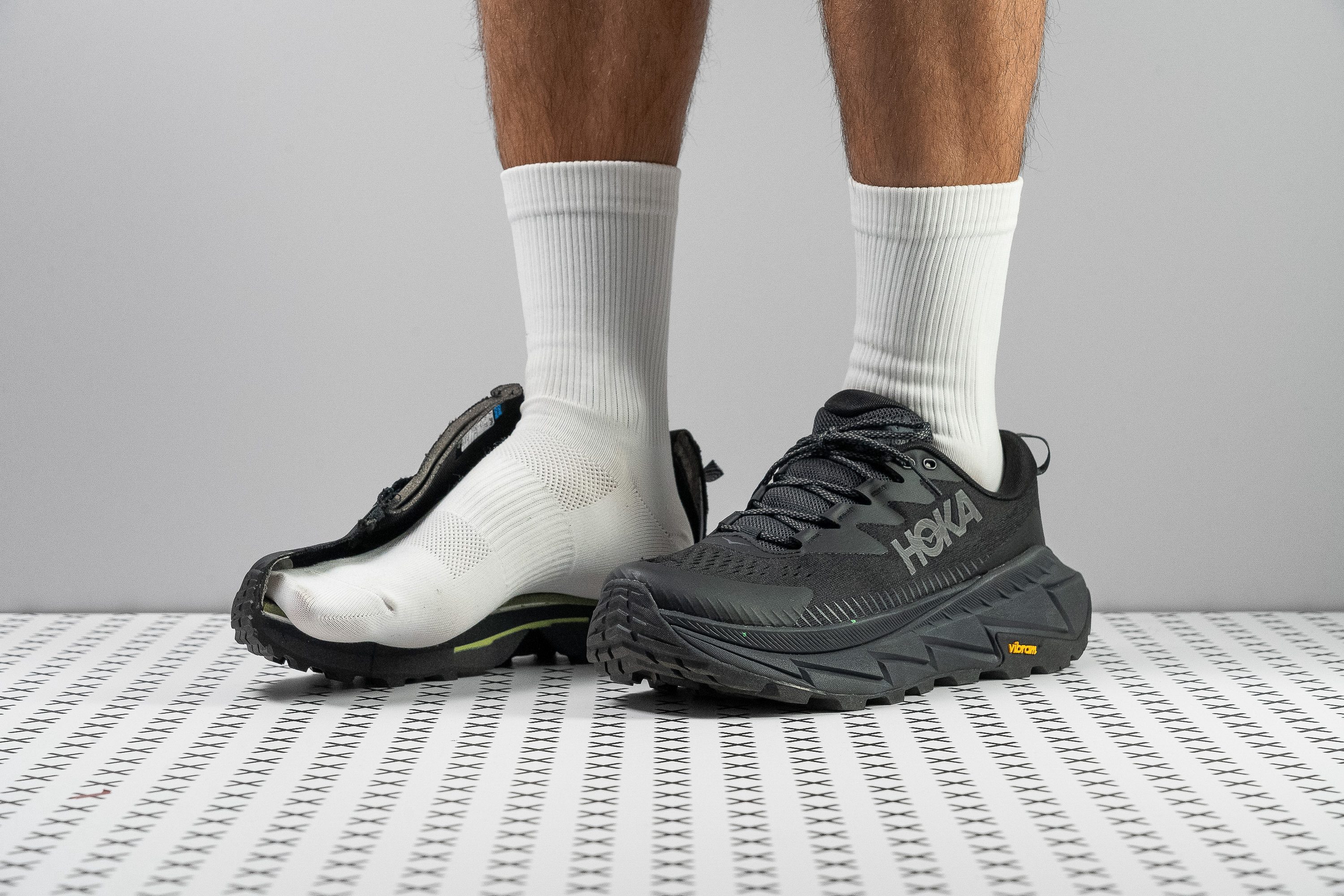Our verdict
- Top pick in best summer hiking shoes
Pros
- Extremely well-cushioned
- Devilishly comfortable
- Responsive, rockered midsole
- Works for light trail running
- Excellent multi-terrain traction
- Highly breathable upper
- Feels surprisingly stable
- Performs consistently in the cold
- Made of sustainable and plant-based materials
Cons
- Questionable durability
- Narrow toebox
- Upper dries slowly
Audience verdict
Comparison
The most similar hiking shoes compared
+ + Add a shoe | |||||
|---|---|---|---|---|---|
| Audience score | 81 Good! | 84 Good! | 85 Great! | 88 Great! | |
| Price | $175 | $70 | $170 | $140 | |
| Trail terrain | Moderate | LightModerate | Light | Moderate | |
| Shock absorption | - | Moderate | High | High | |
| Energy return | - | Moderate | High | Low | |
| Weight lab Weight brand | 14.5 oz / 410g 14.9 oz / 423g | 13.4 oz / 380g 12.3 oz / 350g | 11 oz / 312g | 11.6 oz / 329g 12.3 oz / 350g | |
| Lightweight | ✗ | ✓ | ✓ | ✓ | |
| Breathability | Breathable | Breathable | Moderate | Breathable | |
| Use | Day HikingLight HikingUrban hiking | Day HikingLight HikingBeginners | Day HikingLight HikingUrban hiking | Day HikingSpeed HikingLight Hiking | |
| Orthotic friendly | ✓ | ✓ | ✓ | ✓ | |
| Drop lab | 8.0 mm | 13.7 mm | 9.1 mm | 15.0 mm | |
| Size | True to size | True to size | Slightly small | Half size small | |
| Midsole softness | Balanced | Balanced | Firm | Soft | |
| Difference in midsole softness in cold | Small | Big | Normal | Normal | |
| Torsional rigidity | Stiff | Stiff | Moderate | Stiff | |
| Heel counter stiffness | Moderate | Moderate | Flexible | Flexible | |
| Stiffness | Stiff | Flexible | Moderate | Moderate | |
| Outsole hardness | Average | Average | Average | Average | |
| Material | Knit | LeatherMeshSuede | Mesh | Mesh | |
| Season | SummerAll seasons | SummerAll seasons | All seasons | SummerAll seasons | |
| Toebox durability | Very bad | Very good | Decent | Very good | |
| Heel padding durability | Bad | Bad | Bad | Bad | |
| Outsole durability | Decent | Decent | Good | Good | |
| Width / fit | Narrow | Medium | Medium | Medium | |
| Toebox width | Medium | Medium | Wide | Wide | |
| Lug depth | 3.7 mm | 3.2 mm | 2.5 mm | 3.7 mm | |
| Heel stack lab | 39.0 mm | 32.7 mm | 35.5 mm | 38.8 mm | |
| Forefoot | 31.0 mm | 19.0 mm | 26.4 mm | 23.8 mm | |
| Widths available | Normal | NormalWide | Normal | NormalWide | |
| Technology | Vibram | - | - | - | |
| Heel tab | Finger loop | Finger loop | Finger loop | Finger loop | |
| Removable insole | ✓ | ✓ | ✓ | ✓ | |
| Ranking | #26 Bottom 25% | #20 Bottom 42% | #18 Bottom 48% | #9 Top 26% | |
| Popularity | #35 Bottom 1% | #25 Bottom 28% | #19 Bottom 45% | #6 Top 18% |
Who should buy
We recommend the Hoka Skyline-Float X as a great choice for:
- Hikers who prioritize comfort and want a high-stacked shoe that not only shields their feet from the trail below but pampers them past all their mile markers.
- Speedy hikers looking for a responsive ride that's versatile enough to serve as a trail running shoe.
- Backpackers in the market for a stable and supportive shoe for their next long-haul journey.
- Nature lovers who will appreciate Hoka's focus on sustainable and plant-based materials in this model in order to reduce its carbon footprint.
- Year-round adventurers in need of a breathable shoe that doesn't turn into an ice block when exposed to cold conditions.

Who should NOT buy
As is often the case with Hokas, the Skyline-Float X's toebox is on the narrower side, making it less than ideal for those with broad feet. For an alternative with more internal real estate, we recommend the Teva Grandview GTX Low instead.
With almost nothing in the form of protective overlays, the Skyline-Float X's knit upper suffers from lackluster durability. This leaves the toebox quite vulnerable to getting snagged or ripped as we traverse rougher, more unkempt trails. For those who prioritize durability in their hiking shoes, the KEEN NXIS Speed boasts a much hardier upper mesh (and outsole) which admirably withstood our Dremel test.

One nitpick we have with the shoe is its thin and unruly laces that we found ourselves having to retie more frequently than other shoes during testing. The Merrel Moab 3, on the other hand, has chunkier, well-textured laces that remain tied for as long as we had them on.
Cushioning
Heel stack
Despite being described as having a "low-profile cushion bed" by Hoka themselves, we found that there's a substantial 39 mm of foam and rubber separating our heel from the ground according to our caliper measurements. This is much higher than our current average and gives us a lofty amount of cushioning to dampen our landings.
 While being perched above so much material may sound precarious, especially when traversing more uneven trails, Hoka mitigates any shakiness by raising the sidewalls on the medial and lateral sides of the midsole. As such, our foot feels more cradled within the cushioning rather than sitting flat on top of it.
While being perched above so much material may sound precarious, especially when traversing more uneven trails, Hoka mitigates any shakiness by raising the sidewalls on the medial and lateral sides of the midsole. As such, our foot feels more cradled within the cushioning rather than sitting flat on top of it.

The midsole also flares out to the rear, forming what has been dubbed the "swallowtail heel". It juts out enough to give us some added surface area to land on and promotes a smooth transition while still being subtle enough to be caught when descending stairs. Not to mention, it looks pretty cool too.
| Hoka Skyline-Float X | 39.0 mm |
| Average | 32.8 mm |
Forefoot stack
Further debunking the "low-profile" statement is the gargantuan forefoot stack which we measured to be a whopping 31 mm thick. Apart from being significantly higher than our current lab average, this amount of material at the forefoot rivals what most hiking shoes have at the heel!
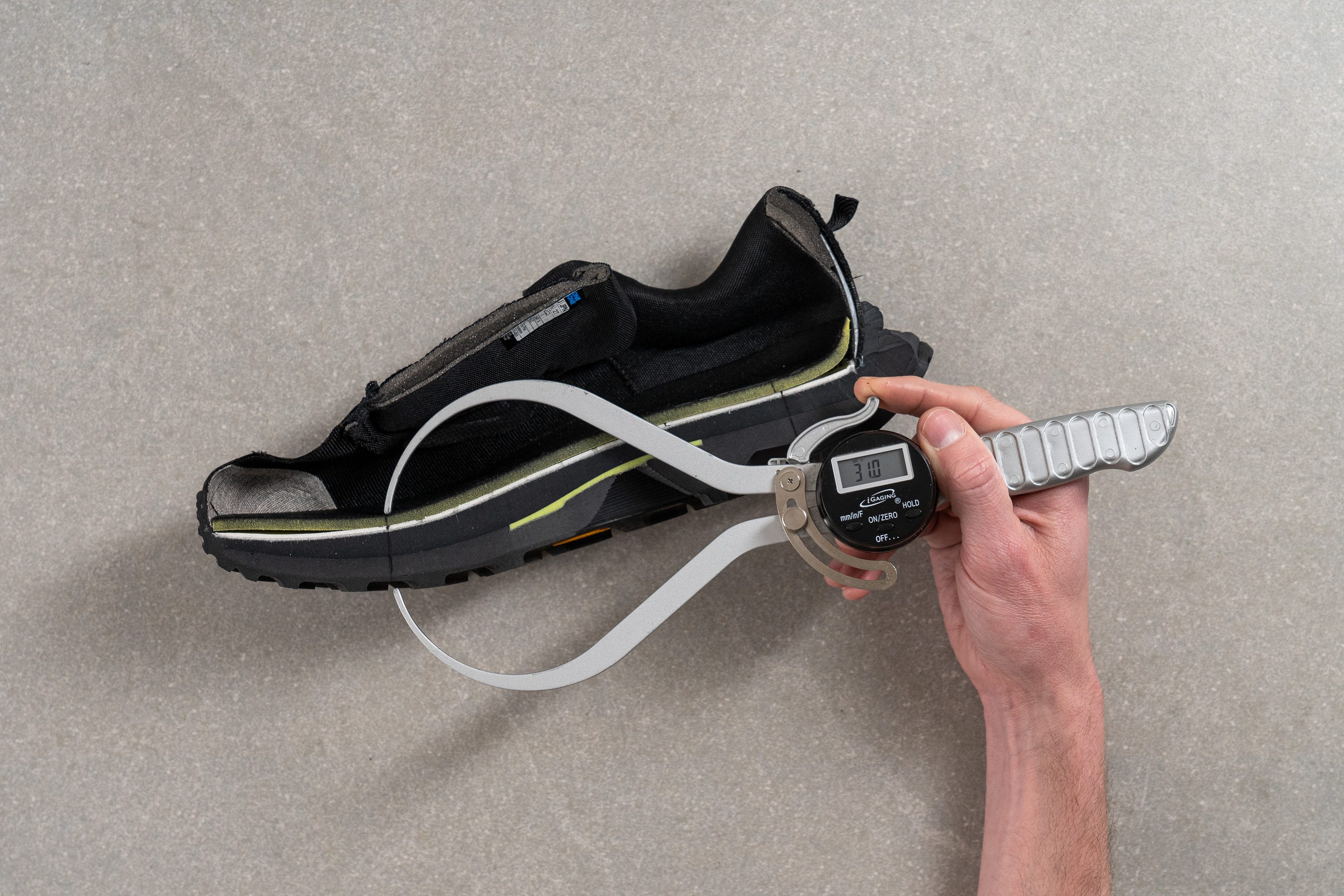
Having so much foam underfoot allows us to really sink into the midsole and savor its satisfying squish with every step. On the flip side though, it almost entirely erases any sense of the ground below which might be jarring for those accustomed to lower-stacked shoes. For those hikers, we recommend looking into the Salomon Outpulse as a well-cushioned but more grounded alternative.
| Hoka Skyline-Float X | 31.0 mm |
| Average | 22.0 mm |
Drop
While it's advertised as sporting a 5 mm drop, the difference in our stack measurements leaves the Skyline-Float with an actual drop height of 8 mm. This discrepancy aside, the Skyline-Float X still falls in the category of mid-drop shoes.
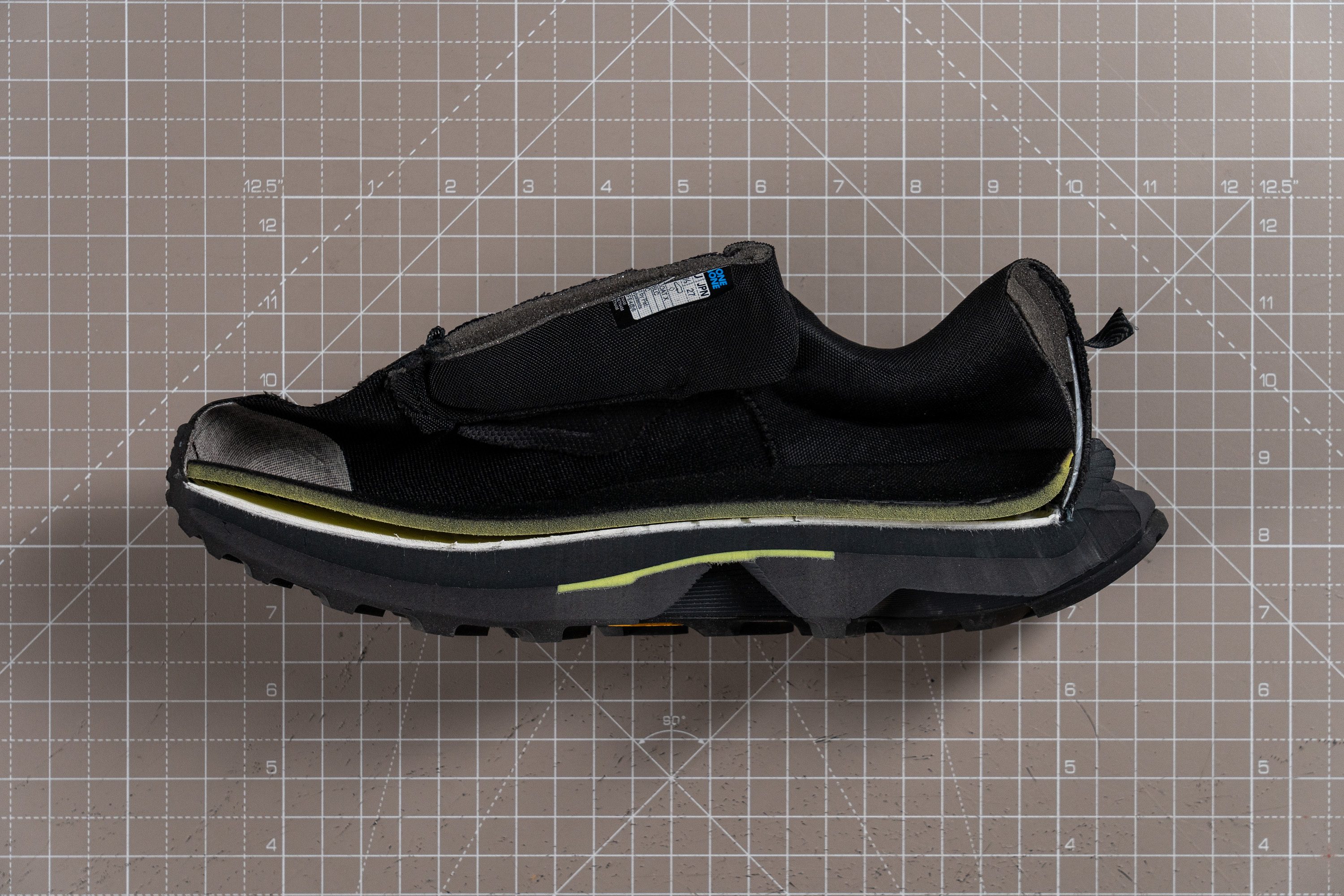
While this doesn't really matter too much when it comes to hiking, it's a nice and versatile offset for those interested in trail running as it caters to all strike patterns quite comfortably.
| Hoka Skyline-Float X | 8.0 mm |
| Average | 10.7 mm |
Midsole softness
The Skyline-Float X's sugarcane-based midsole is made from two separate slabs of foam. Pressing our durometer against the lower part that first makes contact with the ground yields a reading of 27.9 HA. This is on par with our current lab average for hiking shoes and toes the line between balanced and firm cushioning.
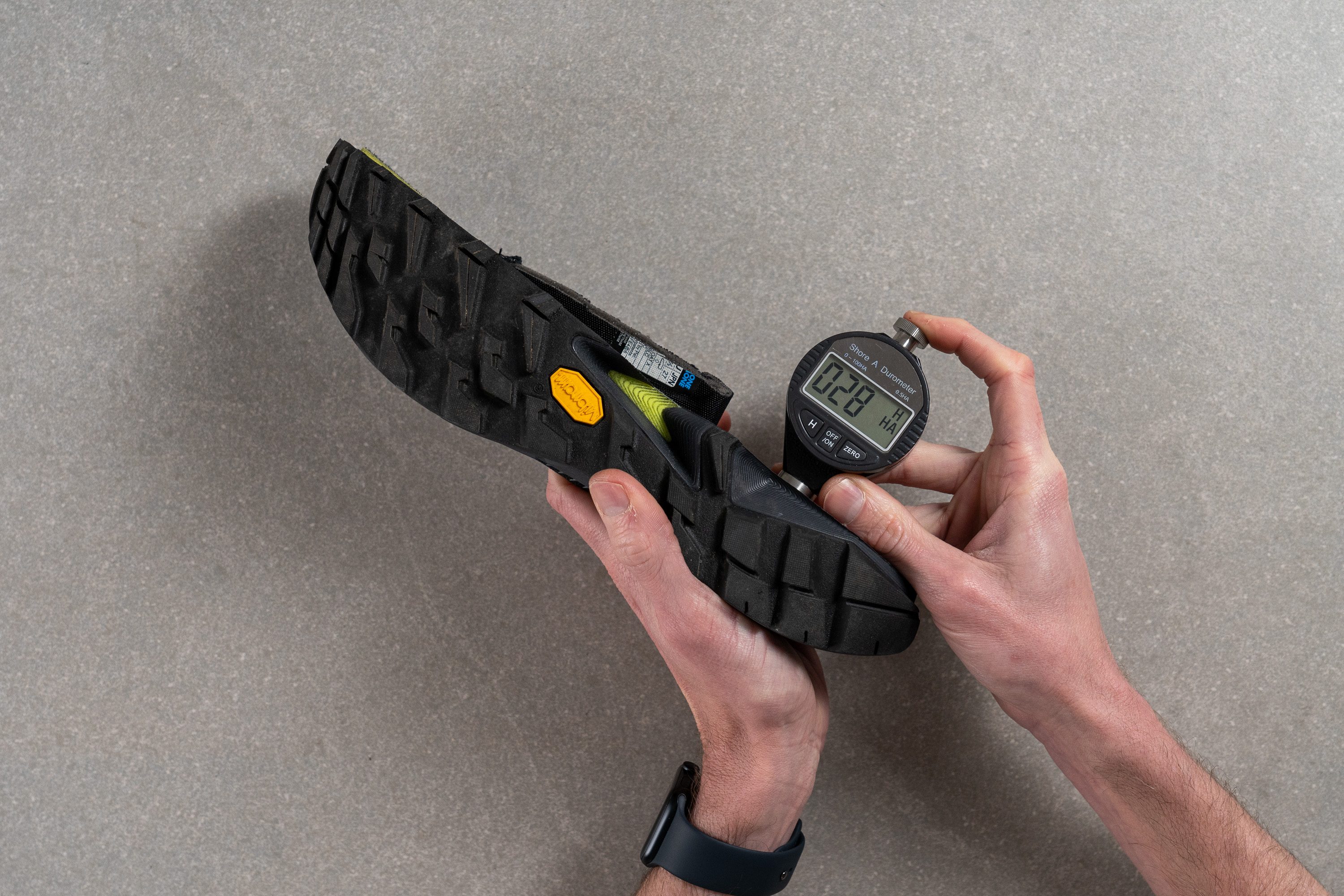
While numbers never lie, we have to say that the shoe feels considerably softer underfoot than our durometer would lead us to believe. The midsole compresses so delicately under our weight as we land, a feeling akin to settling into a memory foam pillow, with a nice and lively rebound as we transition to toe-off.
As such, our feet felt pampered along throughout even our most grueling test hikes with the Skyline-Float X. What's more, we had no issues picking up the pace and doing some impromptu trail runs on days that we felt more energetic.
| Hoka Skyline-Float X | 27.9 HA |
| Average | 27.0 HA |
Secondary foam softness
Next, we pressed our durometer against the upper portion of the midsole and got a reading of 22 HA. This is much more consistent with how pillowy the shoe feels underfloor, with this part of the midsole clearly doing the heavy lifting when it comes to our sense of perceived cushioning.
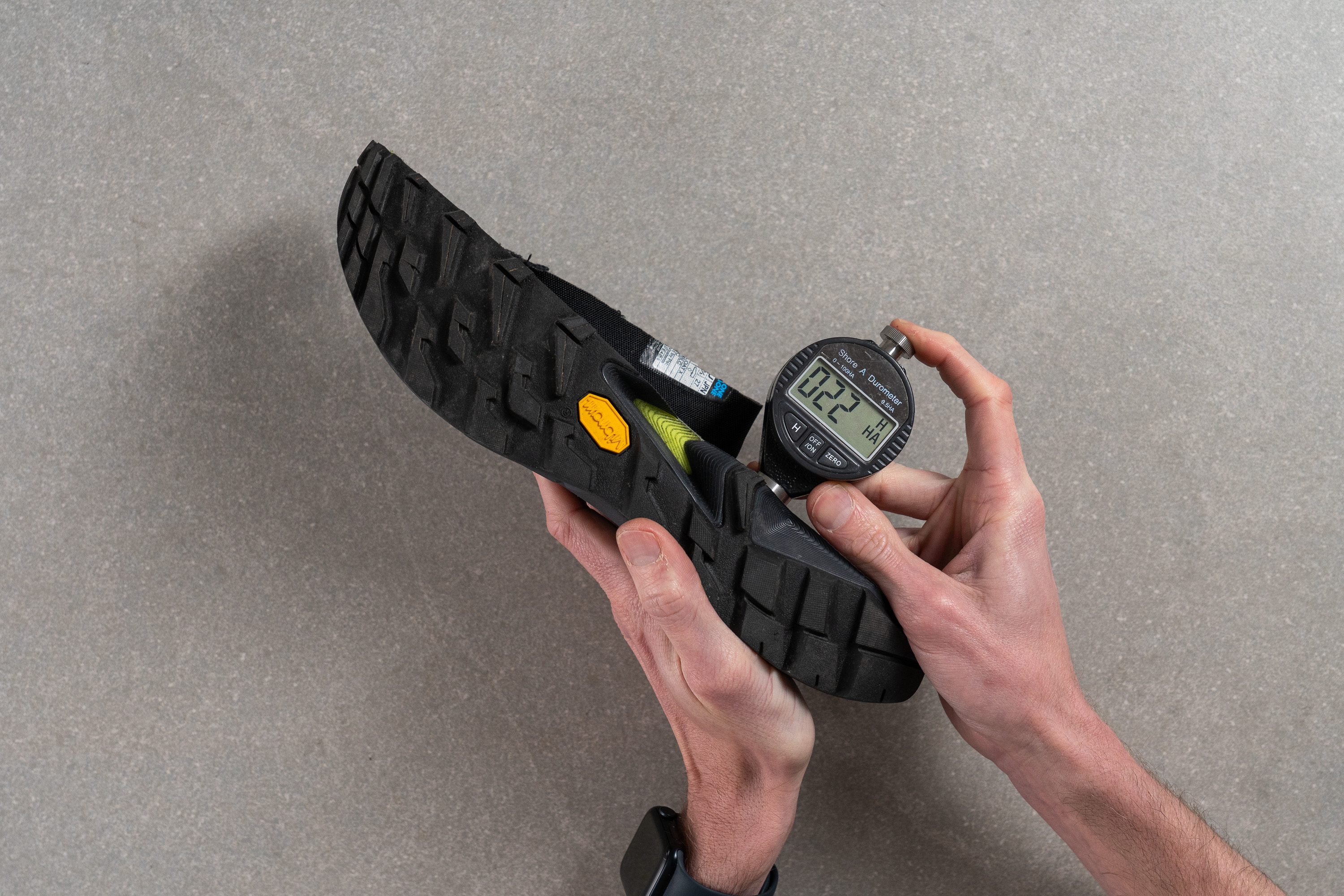
| Hoka Skyline-Float X | 22.0 HA |
| Average | 28.8 HA |
Size and fit
Size
Hoka Skyline-Float X fits true to size (19 votes).
Internal length
| Hoka Skyline-Float X | 270.7 mm |
| Average | 268.7 mm |
Width / Fit
As is often the case with Hokas, the Skyline-Float X boasts a rather close-fitting toebox, measuring only 97.8 mm wide at its widest point according to our caliper. This is quite a bit narrower than our current lab average and means that those with narrow to medium width fit will enjoy a snug, locked-in fit. As an added bonus, the combination of a tight toebox with a broad midsole serves to really lock our foot in place within the shoe which further contributes to its stable ride.
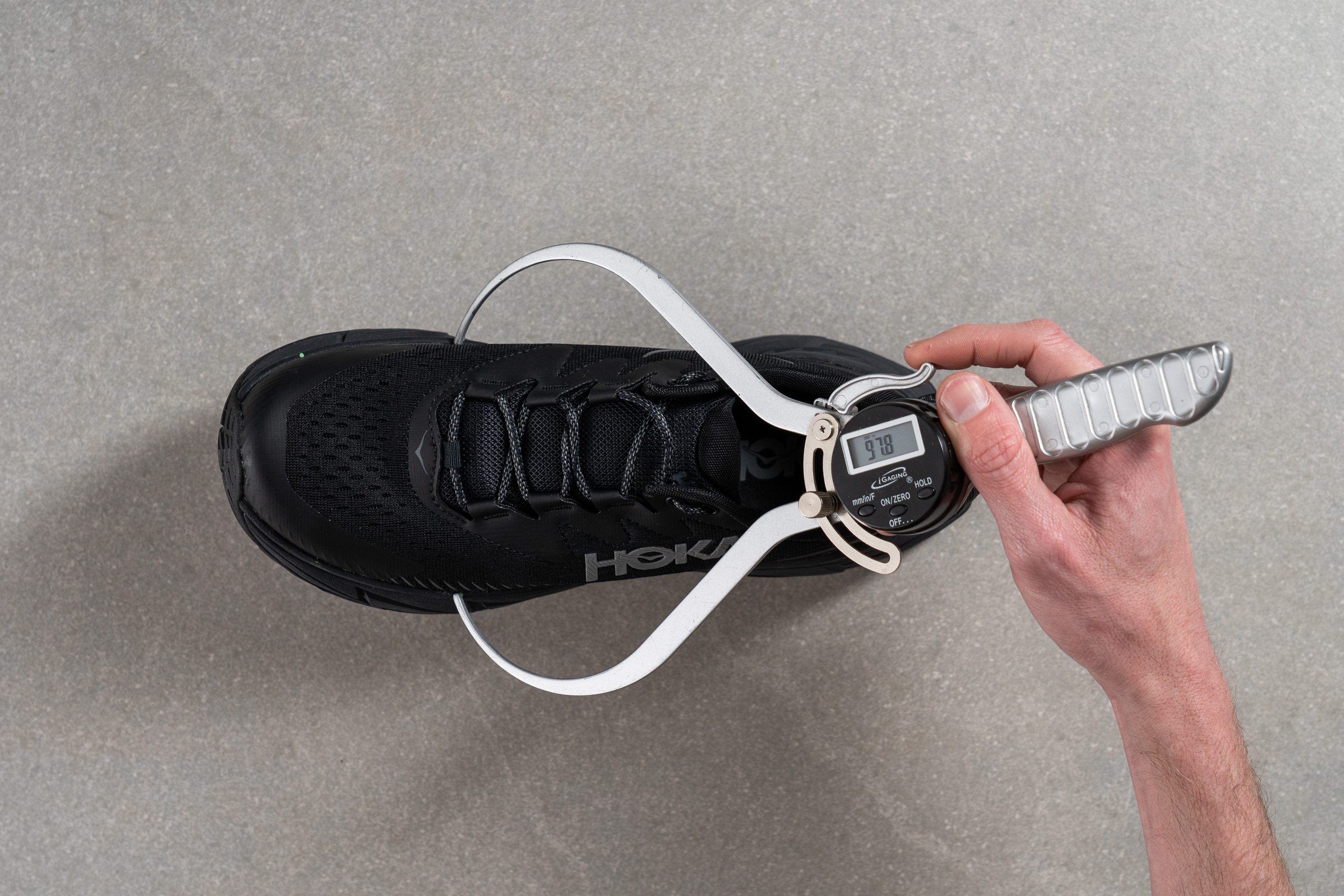
This test follows an older methodology, which is why you don't see recently tested shoes in the chart. Results from different methodologies can not be compared.
| Hoka Skyline-Float X | 97.8 mm |
| Average | 100.5 mm |
Toebox width
Moving up to the area around the big toe, the Skyline-Float X's toebox is only 78.3 mm wide based on our caliper measurements. This is also narrower than our current lab average, thus limiting our toes' ability to splay out naturally during our stride. While this also contributes to the shoe's secure fit on our foot, it's also a recipe for blisters for hikers with broad feet. For those in need of a roomier alternative, we recommend the similarly pillowy Teva Grandview GTX Low.
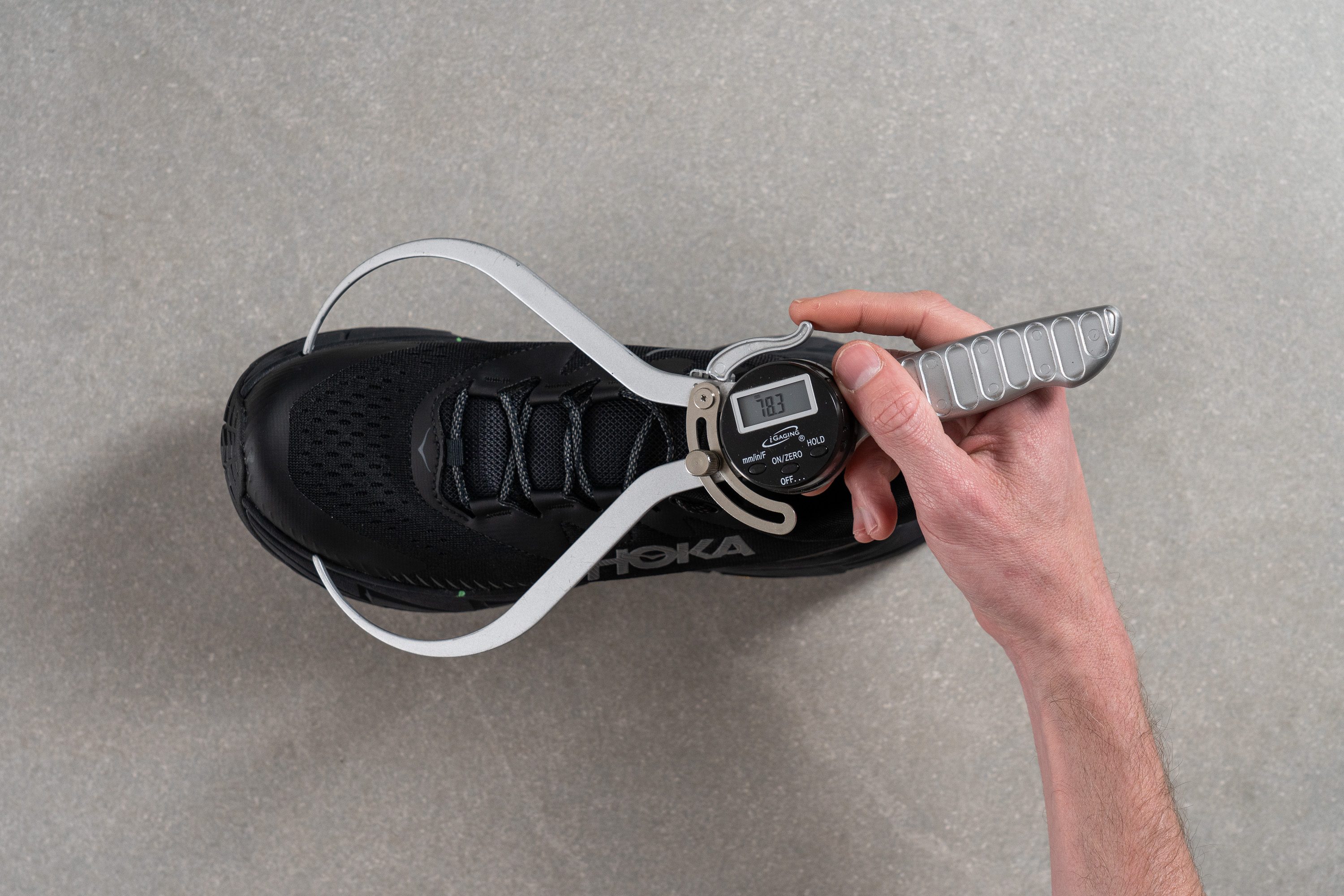
This test follows an older methodology, which is why you don't see recently tested shoes in the chart. Results from different methodologies can not be compared.
| Hoka Skyline-Float X | 78.3 mm |
| Average | 81.0 mm |
Traction / Grip
Lug depth
We measured the Skyline-Float X's lugs to be 3.7 mm thick which is within spitting range of our current lab average. These are deep enough to bite into softer surfaces and provide excellent grip during our test hikes. That said, their shape and orientation aren't so aggressive that the shoe feels strange when walking on asphalt or paved urban areas.

What's more, the flatness of the lugs and stickiness of the Vibram compound served us well on smoother surfaces and while scrambling up boulders. Even wet and muddy surfaces were no cause for concern during our test hikes, with the wide spaces between the lugs allowing us to shed mud and debris rather easily. The only little nitpick we had was with little rocks occasionally getting jammed between the treads at the heel when we were testing on more gravelly trails.
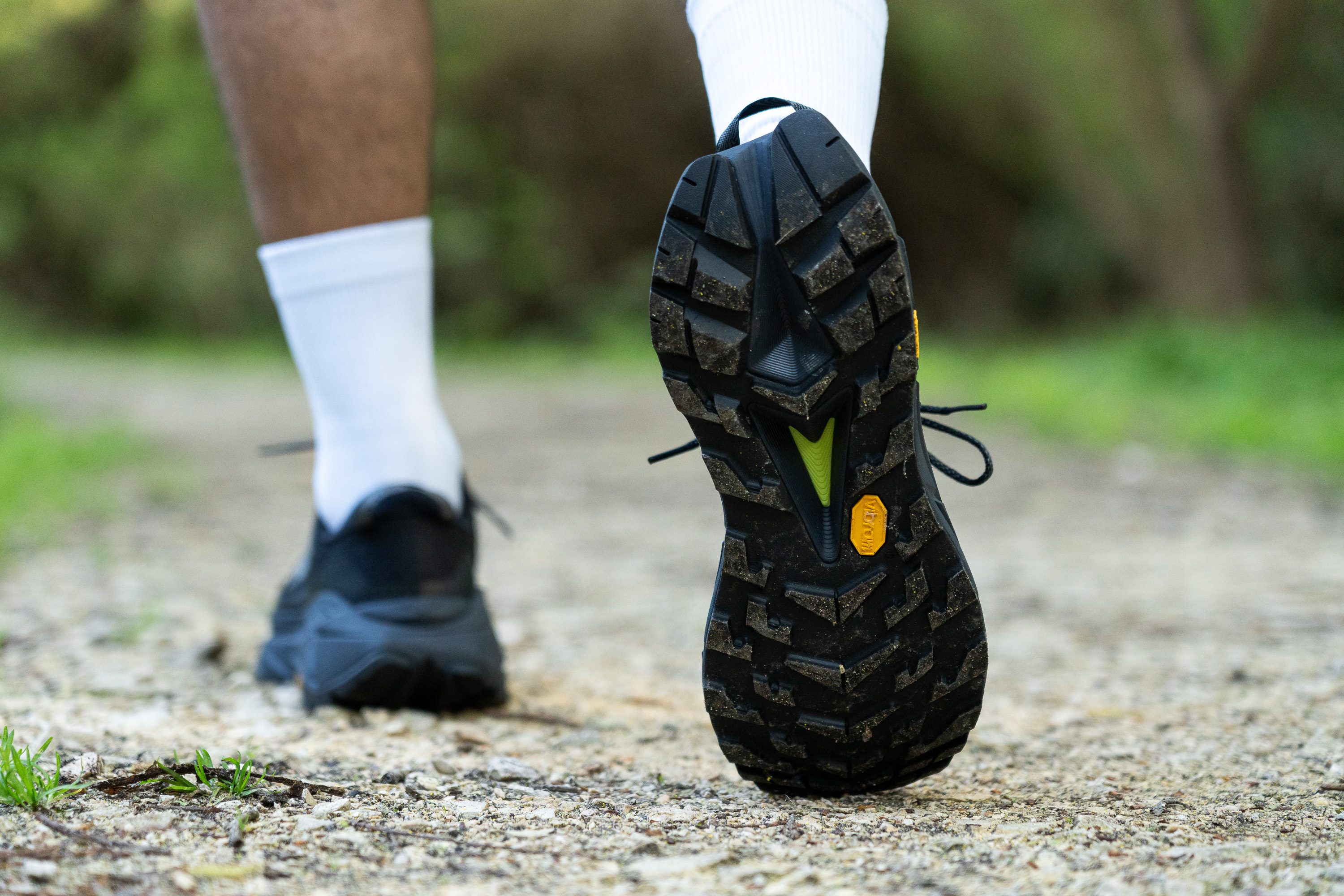
| Hoka Skyline-Float X | 3.7 mm |
| Average | 4.0 mm |
Flexibility / Stiffness
Apart from a high level of torsional stiffness, the shoe's stack and embedded plate also impart a high level of longitudinal stiffness as our flex test demonstrates. With 47.3N of force required to bend the shoe to 90 degrees, the Skyline-Float X is significantly stiffer than the average hiking shoe.
This further contributes to the shoe's supportive feel as it prevents unnecessary foot flexion which helps in delaying the onset of foot fatigue. We found this to be especially useful during our longer excursions and whenever we were toting along a heavy pack.
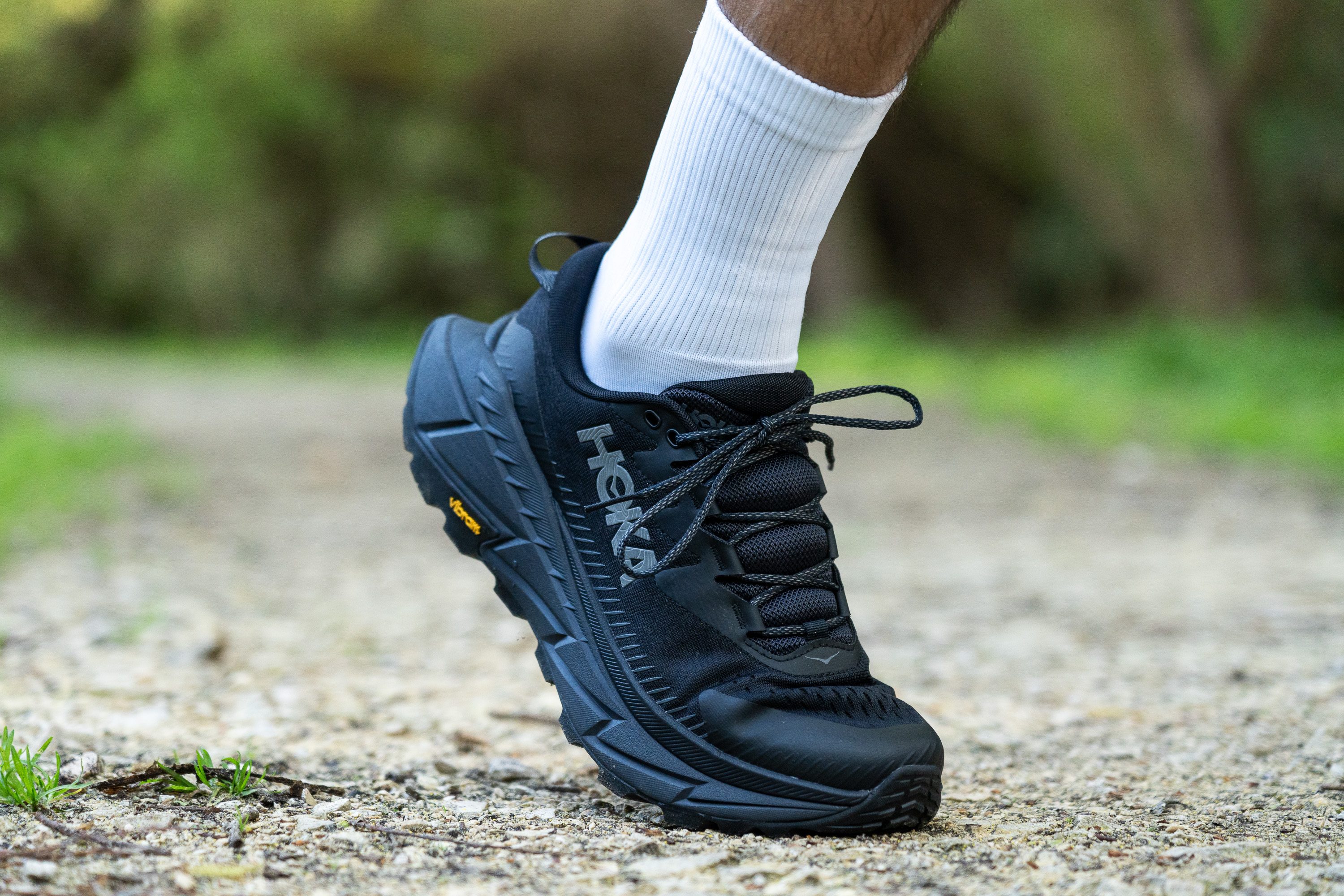
This test follows an older methodology, which is why you don't see recently tested shoes in the chart. Results from different methodologies can not be compared.
| Hoka Skyline-Float X | 47.3N |
| Average | 29.6N |
Stiffness in cold (%)
While the Skyline-Float X starts off quite stiff at room temperature, we were pleased to find that it only became 3.6% stiffer upon repeating the flex test after leaving it in our freezer for twenty minutes. As such, the shoe is much more consistent than the average hiking shoe in this regard and shouldn't feel very different underfoot as surrounding temperatures drop. With this in mind along with the midsole's post-freezer result, we recommend the Skyline-Float X as a great companion for treks in the cooler parts of the year, given it's paired with a warm pair of socks.
| Hoka Skyline-Float X | 4% |
| Average | 28% |
Weight
The Skyline-Float X isn't quite as light as its name might suggest; tipping our scales at a heavier-than-average 14.5 oz (410g).
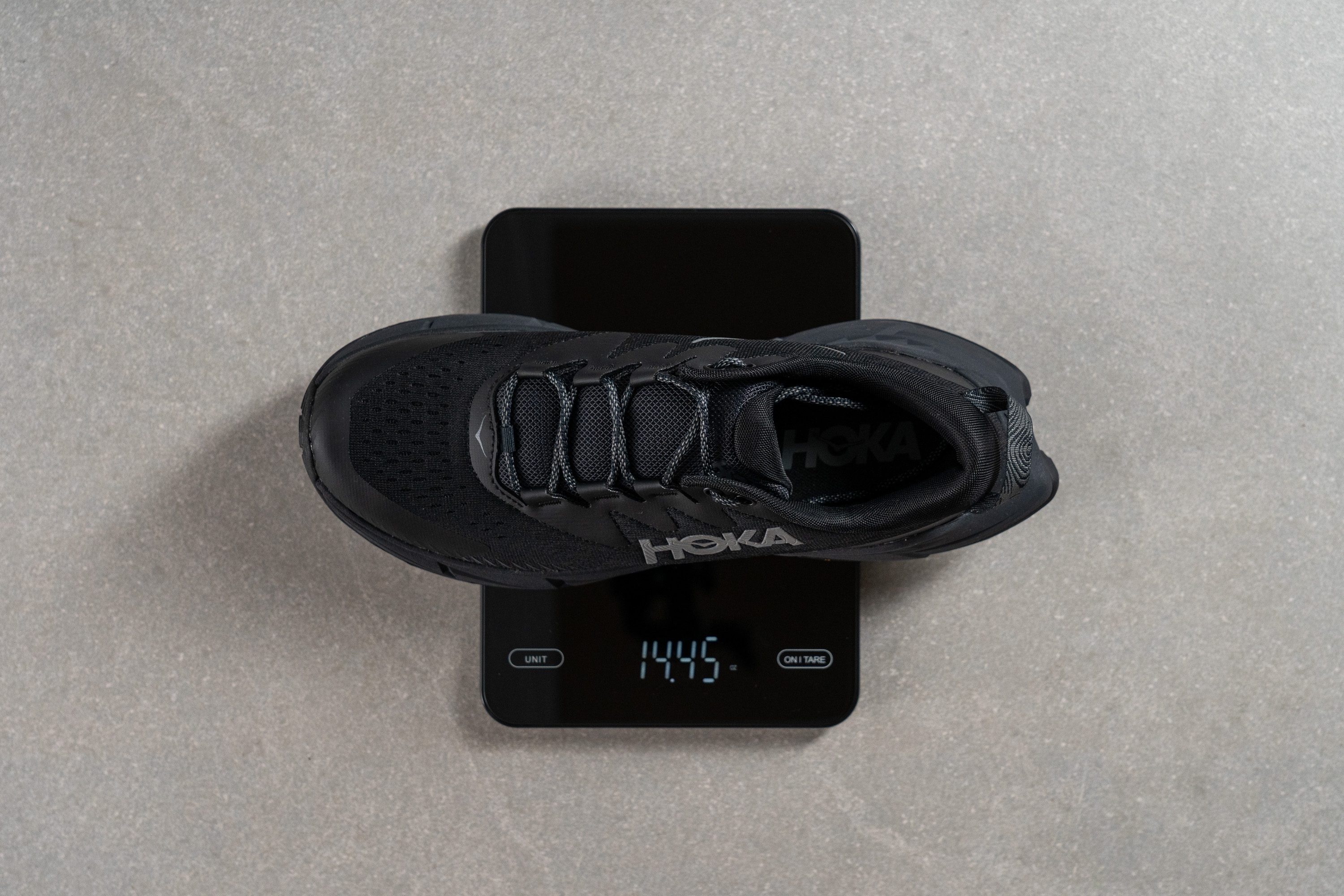
In spite of this, however, the Skyline-Float X still manages to feel rather svelte and nimble underfoot, even enabling us to do some light jogging as we tested it on the trails. This is thanks to the lively and rockered sugarcane midsole, not to mention the rigid and responsive Pebax plate embedded between its two distinct layers; features we'll delve into further below.
| Hoka Skyline-Float X | 14.5 oz (410g) |
| Average | 13.4 oz (380g) |
Breathability
We pumped the Skyline-Float X full of smoke in order to assess how breathable it is. As the footage of the test demonstrates, the smoke immediately filters through the knit upper and churns out steadily throughout the shoe. This earns the Skyline-Float X a perfect 5 out of 5 for breathability, making it an excellent choice for hikes on warm summer days.
This is further confirmed when inspecting a cross-section of the shoe over a backlight as we can clearly see the light peeking through the many pores of the knit upper. That said, while better-ventilated shoes tend to dry relatively quickly compared to those that aren't, the Skyline-Float X proves to be an exception to the rule.
The plush nature of the upper material means that it absorbs quite a lot of water which, as we discovered upon dunking the shoe, takes a rather long time to drain and dry out unassisted. For an airy shoe that won't stay soaked after getting submerged in water, we recommend the Nike ACG Watercat+ instead.
While it does have many gaps that promote airflow, it's clear to see how dense the upper material is when inspecting it up close under our microscope. As such, the shoe should still feel somewhat cozy even in cooler weather despite how airy it is.
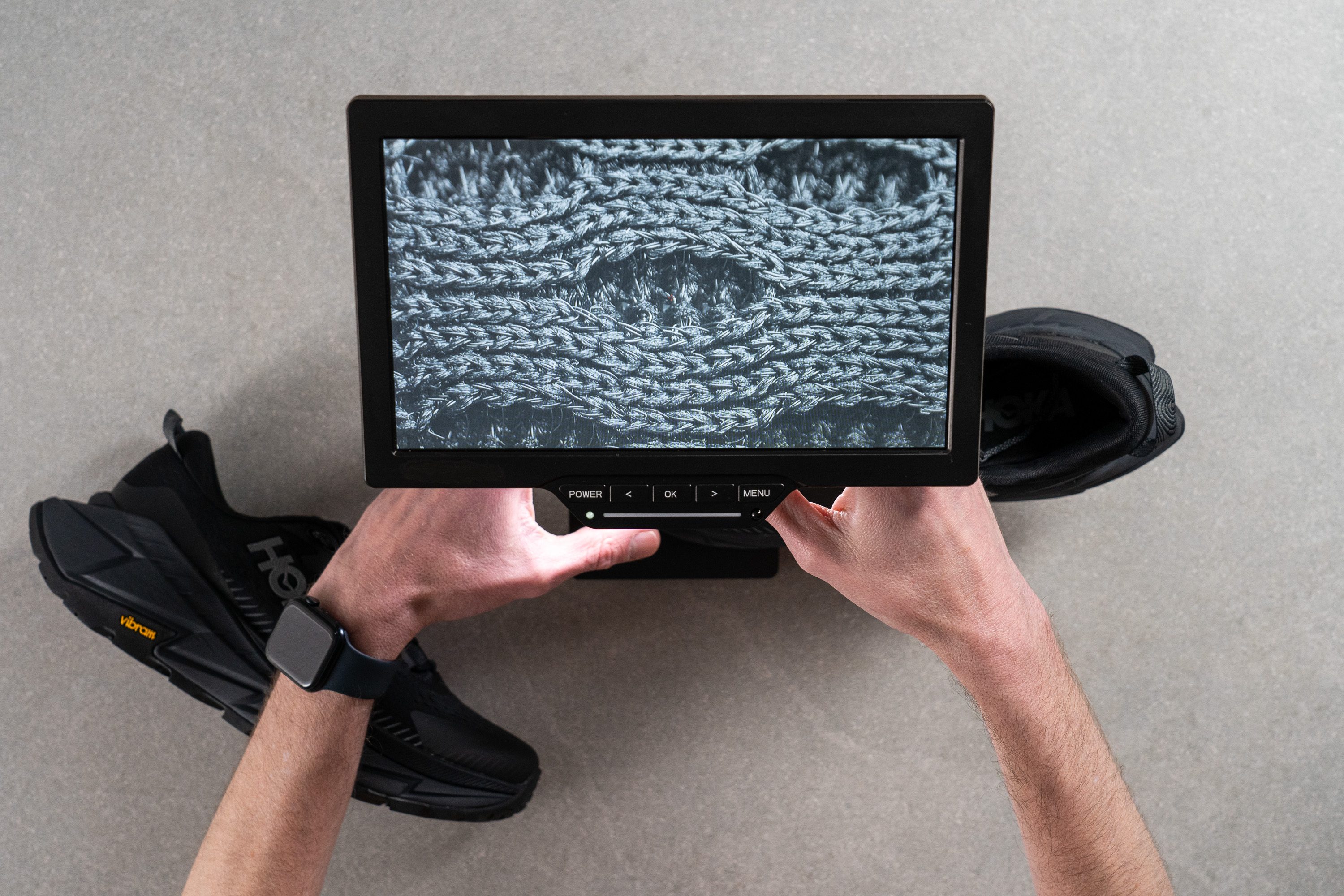

| Hoka Skyline-Float X | 5 |
| Average | 2.4 |
Stability
Lateral stability test
For a shoe that sits on such a robust stack, the Skyline-Float X feels disturbingly well-planted underfoot. Apart from the raised sidewalls we alluded to earlier, Hoka included several clever features in the shoe's design that contribute to its surprisingly stable ride.
Torsional rigidity
Unsurprisingly for a shoe with so much foam and rubber in its sole unit, the Skyline-Float X is extremely rigid, earning a torsional rigidity score of 5 out of 5 on our subjective scale.
Apart from the sheer size of the midsole, the 90% bio-based Pebax plate embedded between the layers of the dual-density midsole also factors into how stiff the shoe is. Its placement at the arch of our foot feels supportive and helps distribute our weight more evenly as we transition from heel to toe.
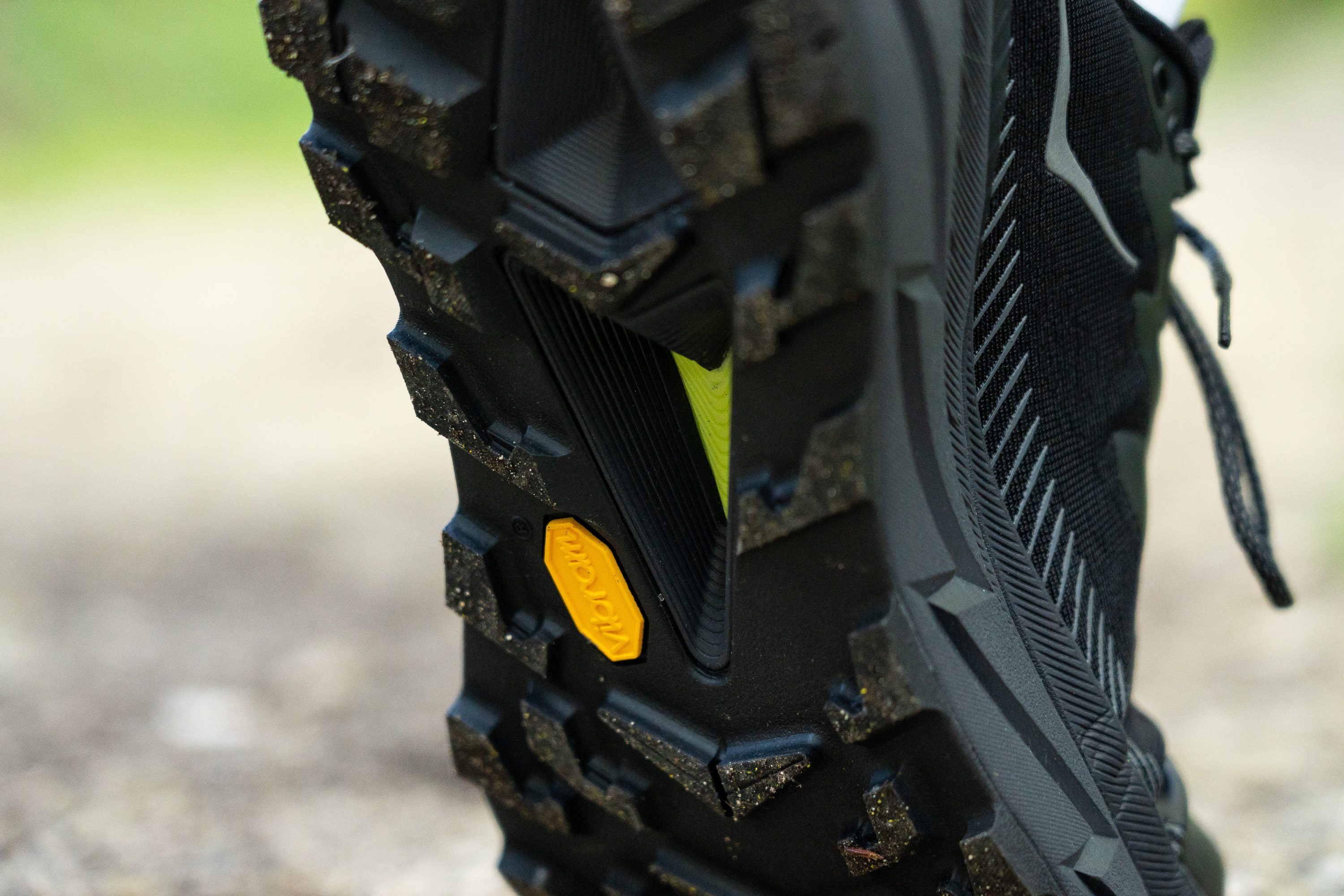
What's more, the plate also acts as a lightweight rock plate; protecting our feet from getting bruised on sharp rocks or gnarled tree roots that we happen to step on.
| Hoka Skyline-Float X | 5 |
| Average | 3.7 |
Heel counter stiffness
The well-padded heel collar isn't quite as rigid but is still structured enough to earn a rather high stiffness score of 4 out of 5 in our manual assessment. As such, the shoe really locks our heel in place while still allowing for some natural lateral movements. In this way, the heel counter presents us with a healthy balance of comfort and stability.
| Hoka Skyline-Float X | 4 |
| Average | 3.7 |
Midsole width - forefoot
One of the most basic ways to ensure stability is to have a broad base, and boy does this shoe have it in spades! At 117.6 mm wide at the forefoot according to our caliper, the Skyline-Float X's midsole is about as staggeringly broad as it is high.
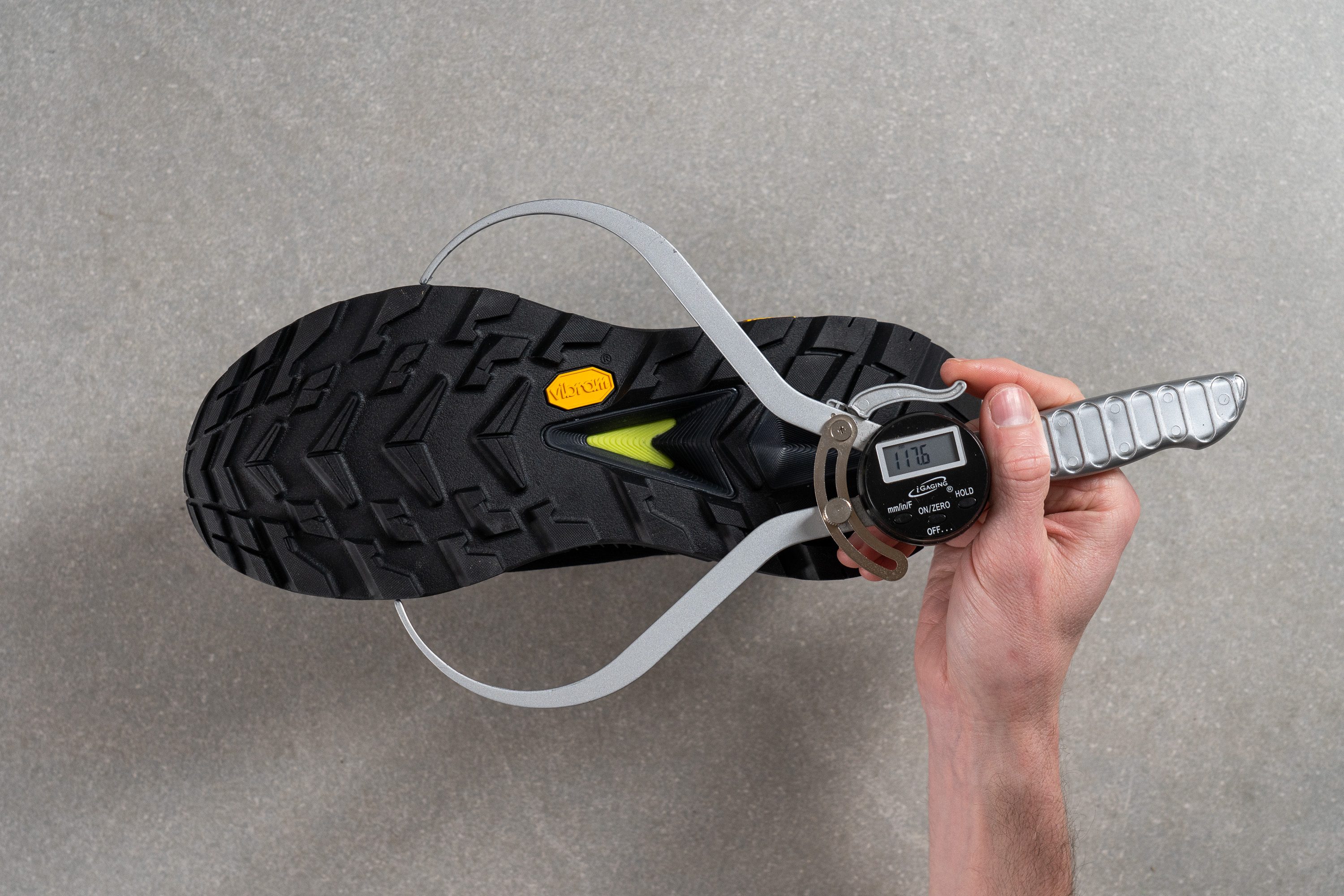
| Hoka Skyline-Float X | 117.6 mm |
| Average | 111.3 mm |
Midsole width - heel
The midsole is just as robust at the heel, measuring 101.6 mm wide according to our caliper. Having such an ample landing platform means that we felt surefooted even when traversing trickier, more technical trails. The biggest tradeoff when it comes to having such a wide midsole, not to mention the swallowtail heel, is the weight that all that extra material adds to the shoe's bulky frame.
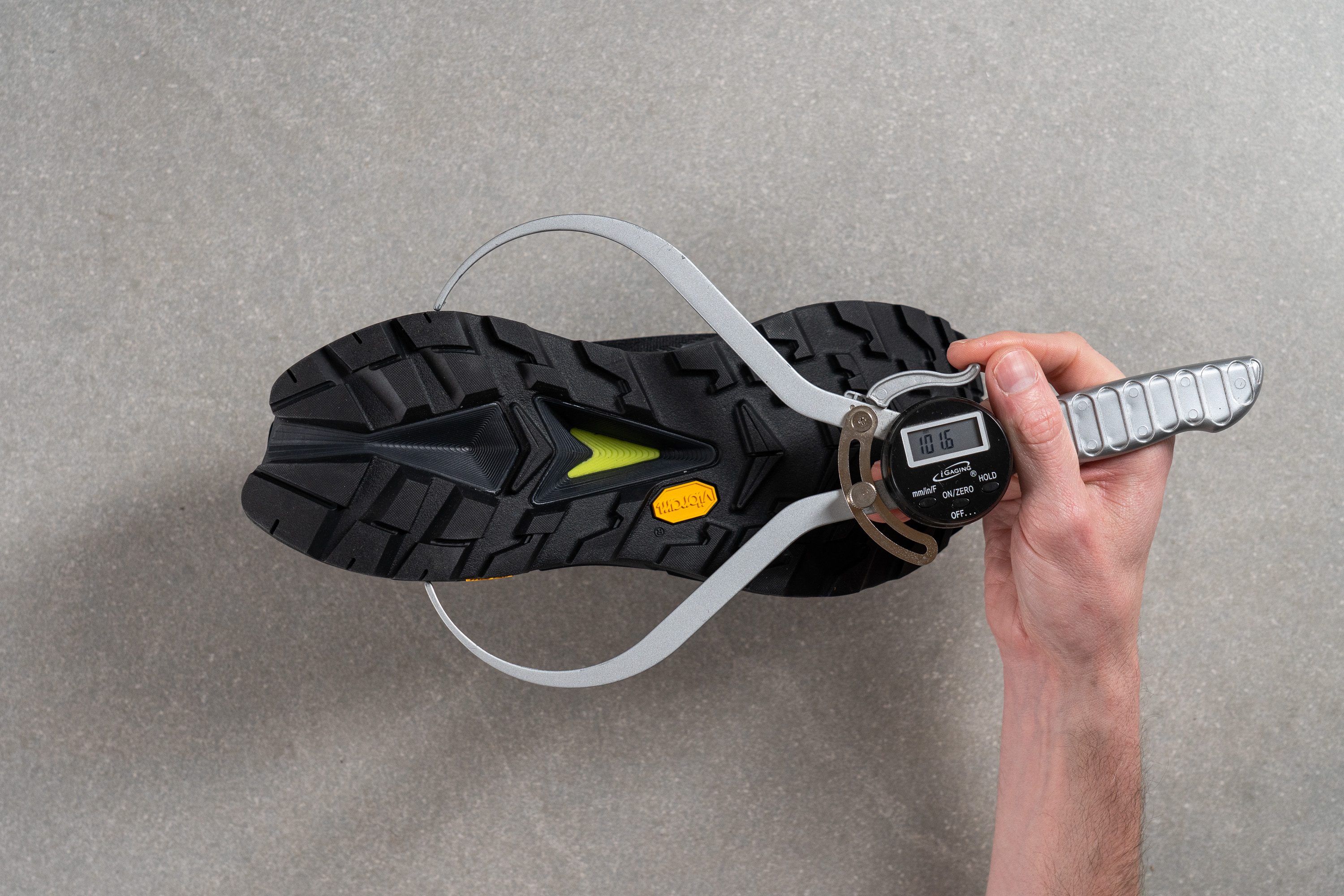
| Hoka Skyline-Float X | 101.6 mm |
| Average | 87.9 mm |
Durability
Toebox durability
To simulate extreme wear and tear, we subjected the Skyline-Float X to several thrashings from our Dremel, starting with the toebox.
Inspecting the damage once the twelve-second test was up, we can see that our tool had made quick work of the unreinforced portion of the toebox, leaving a massive hole in its wake. This leads us to give the Skyline-Float X a rather disappointing toebox durability score of 1 out of 5.
So while the shoe is technically able to tackle more difficult terrains, one unlucky snag could subject our toes to the elements and bring an untimely end to an otherwise excellent shoe.
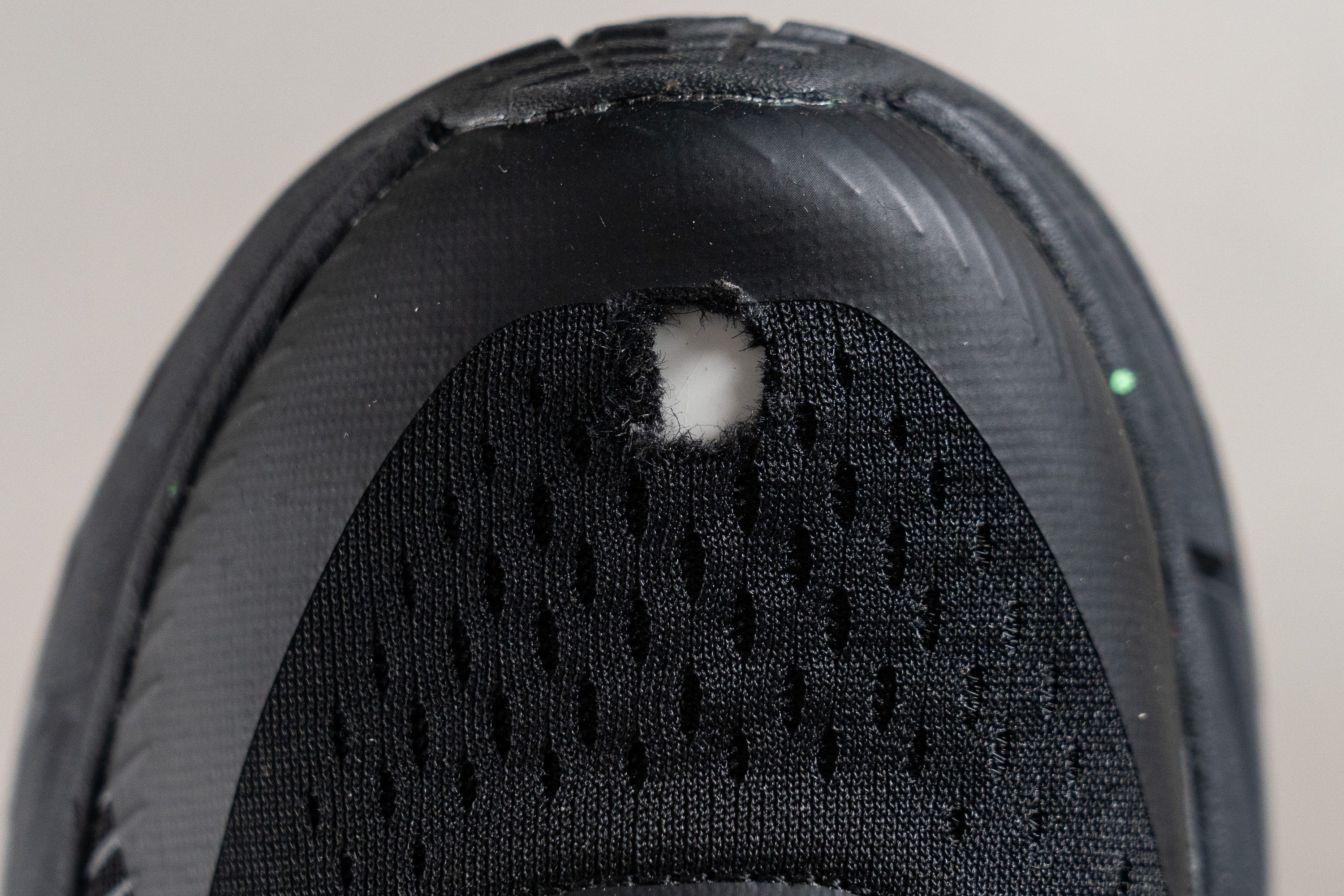
| Hoka Skyline-Float X | 1 |
| Average | 3.7 |
Heel padding durability
Next, we turn our attention to the heel collar and set our Dremel against the shoe once more.
After four seconds, we found that it had performed a little better than the toebox, if only marginally so, thus earning the Skyline-Float X a still disappointing 2 out of 5 for heel padding durability.
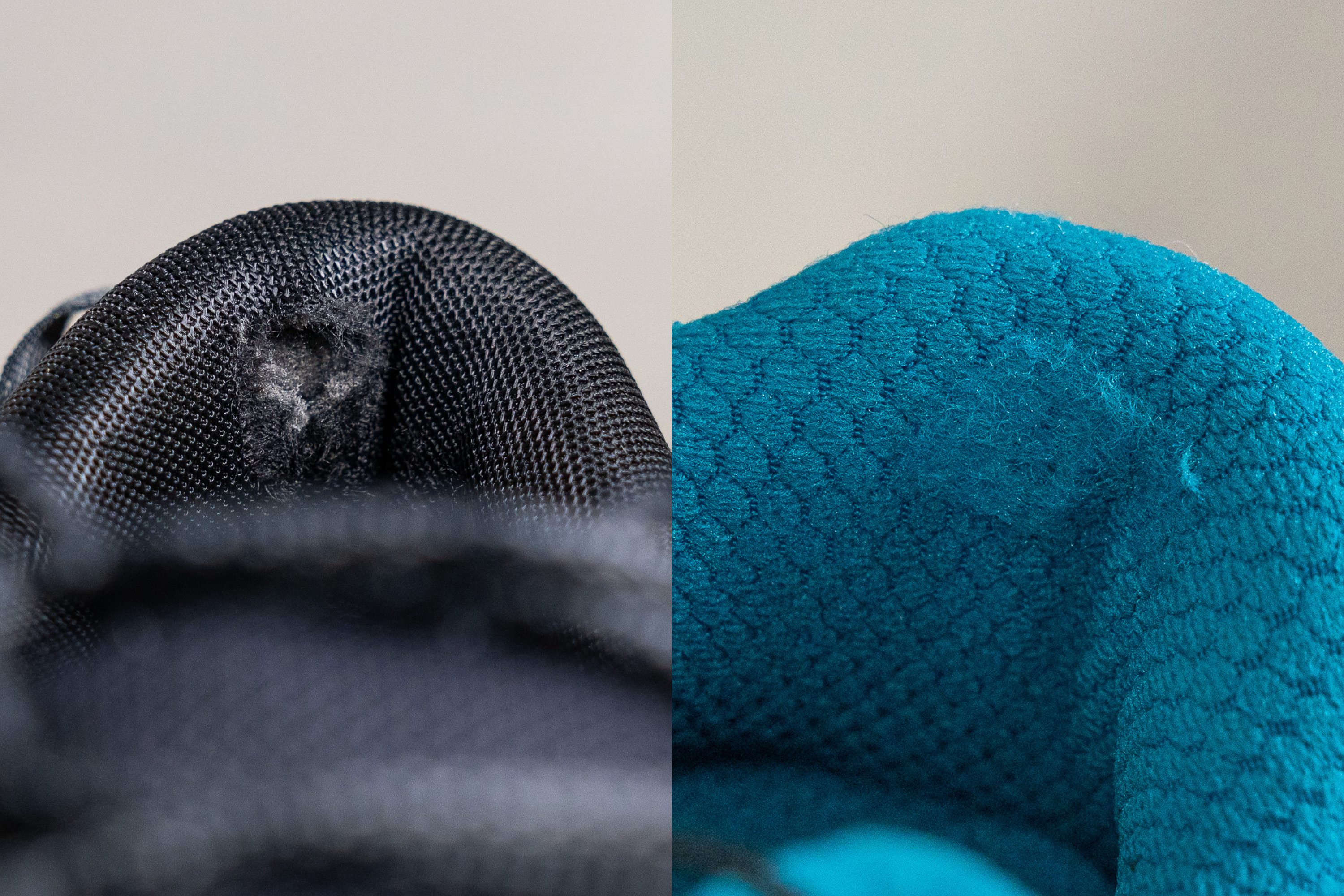
For comparison's sake, look at how well the Salomon Ultra Glide's heel collar held up against our Dremel in this same assessment.
| Hoka Skyline-Float X | 2 |
| Average | 3 |
Outsole hardness
The Skyline-Float X's Vibram outsole is about as hard as our current lab average, giving us a durometer reading of 85.9 HC. This typically indicates a good balance of grip and durability.
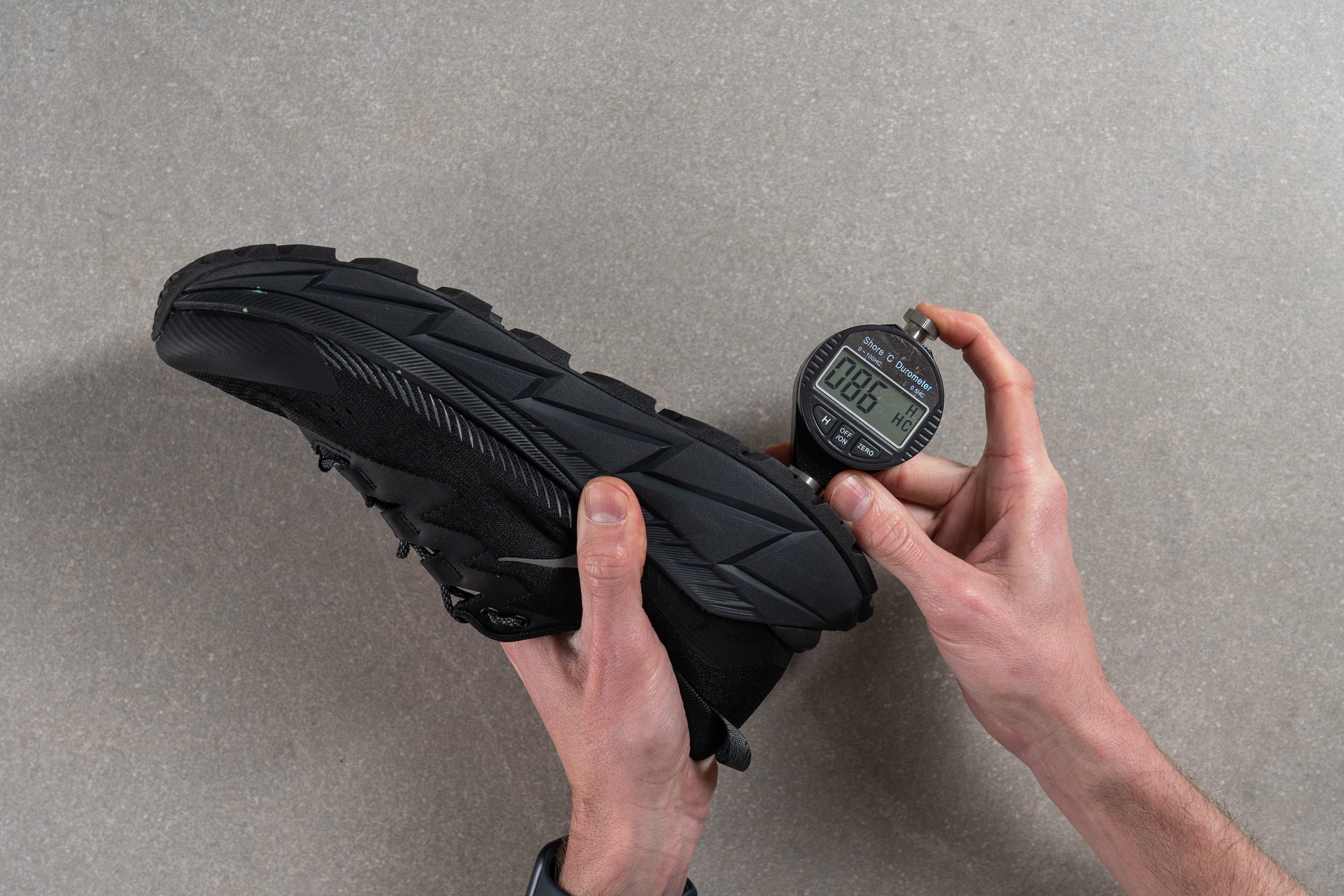
| Hoka Skyline-Float X | 85.9 HC |
| Average | 85.1 HC |
Outsole durability
With its abrasive element now spinning at a faster 10K RPM, we set our Dremel against one of the Skyline-Float X's outsole lugs for twenty-two seconds of grinding.
Once the timer had run out, we used a tire tread gauge and found that we had lopped off 1.1 mm of material from the outsole. This is an average performance in this test as far as hiking shoes go, leading us to predict that the shoe should comfortably last the expected lifespan of 800 miles before any major signs of wear and tear become apparent.
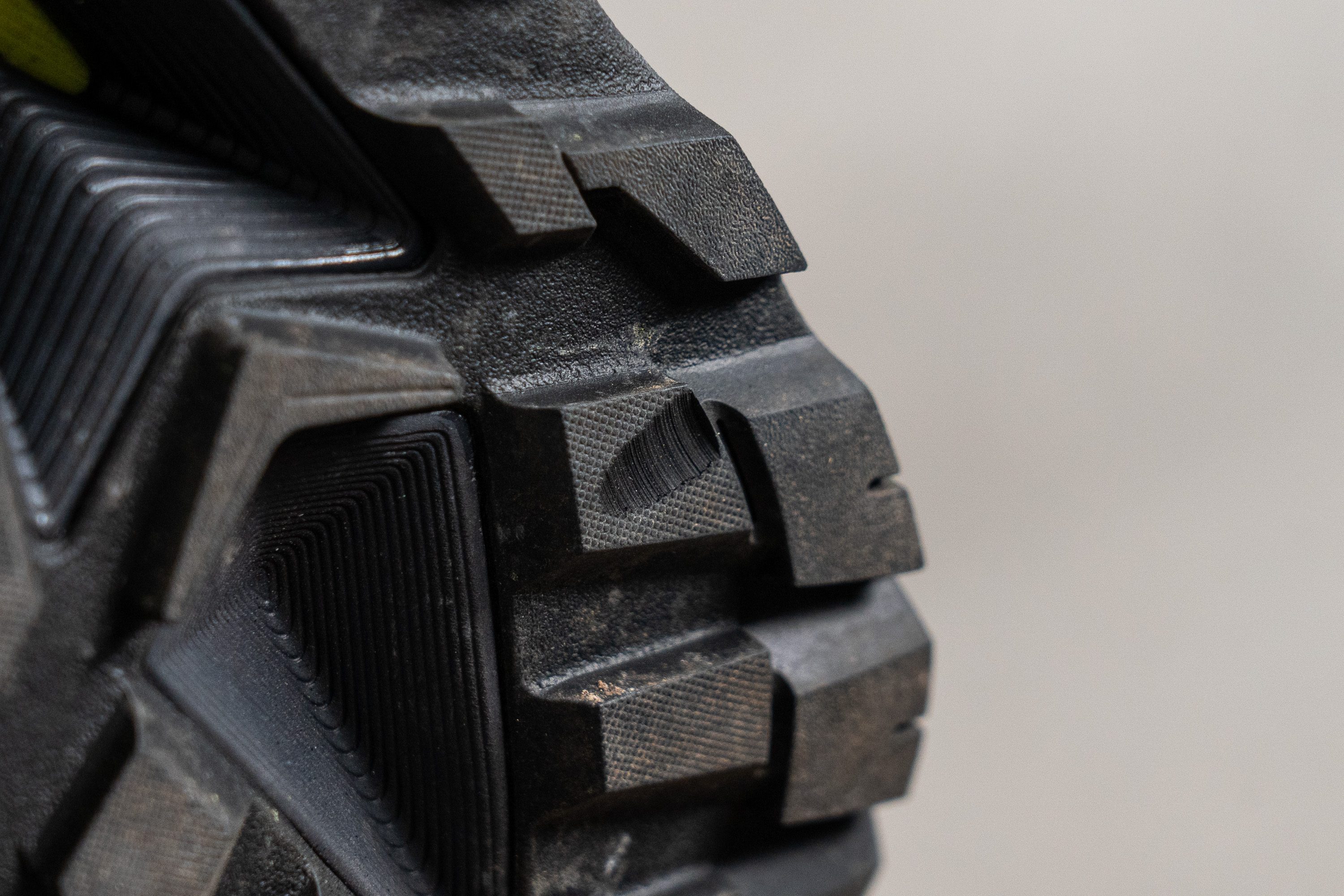
| Hoka Skyline-Float X | 1.1 mm |
| Average | 1.0 mm |
Outsole thickness
At 2 mm thick according to our caliper measurements, the Skyline-Float X's outsole is just shy of our current lab average. When taking the lugs into consideration as well, this gives us a good amount of material to wear through without adding too much weight to an already relatively bulky shoe.
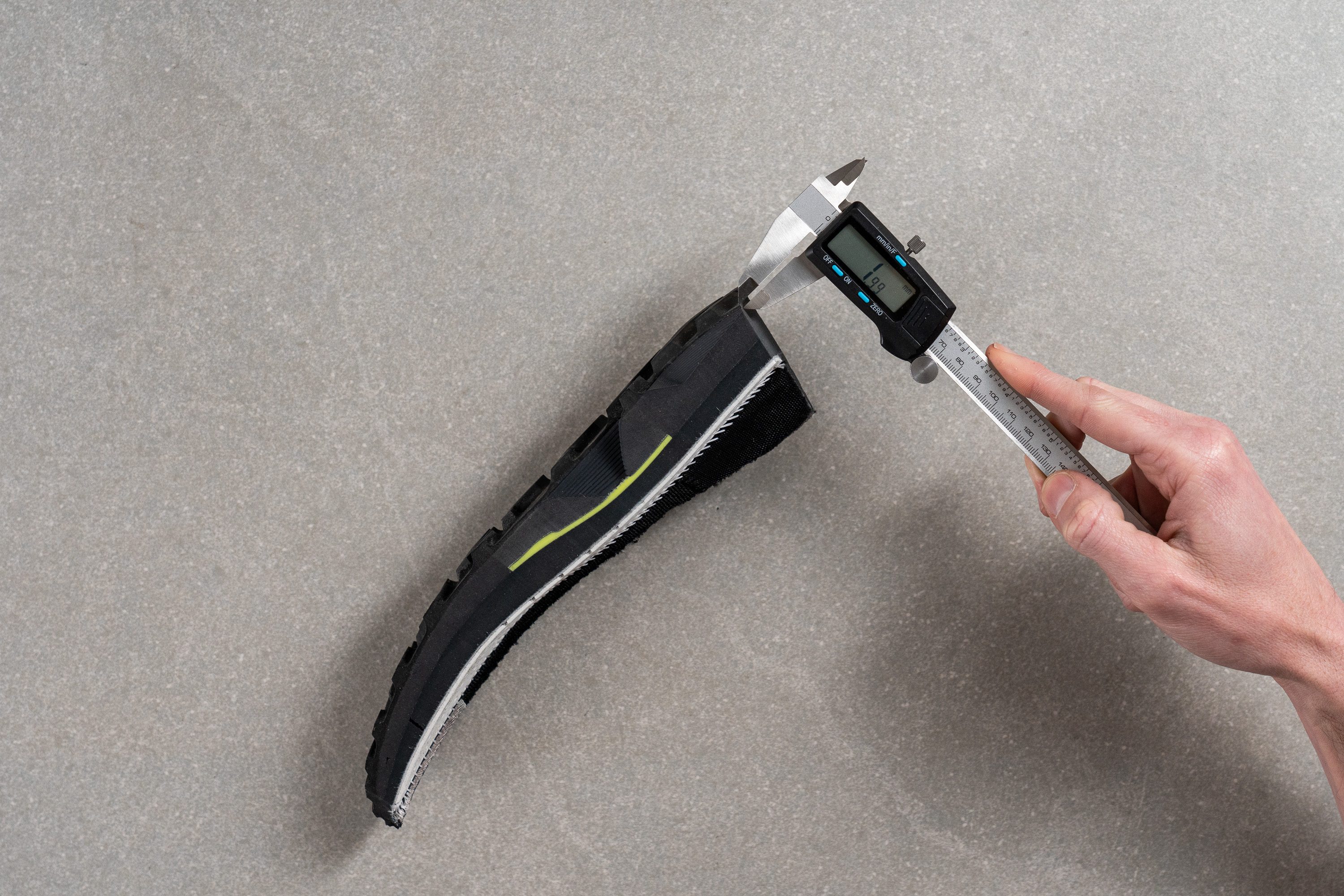
| Hoka Skyline-Float X | 2.0 mm |
| Average | 2.5 mm |
Misc
Insole thickness
At 5 mm thick according to our caliper measurements, the Skyline-Float X's insole is within range of our current lab average. This gives us an adequately padded footbed that softens our landings before the midsole cushioning even kicks in.

| Hoka Skyline-Float X | 5.0 mm |
| Average | 5.3 mm |
Removable insole
The insole isn't glued in so removing it and replacing it for an aftermarket alternative or a custom orthotic for added arch support is possible if necessary.
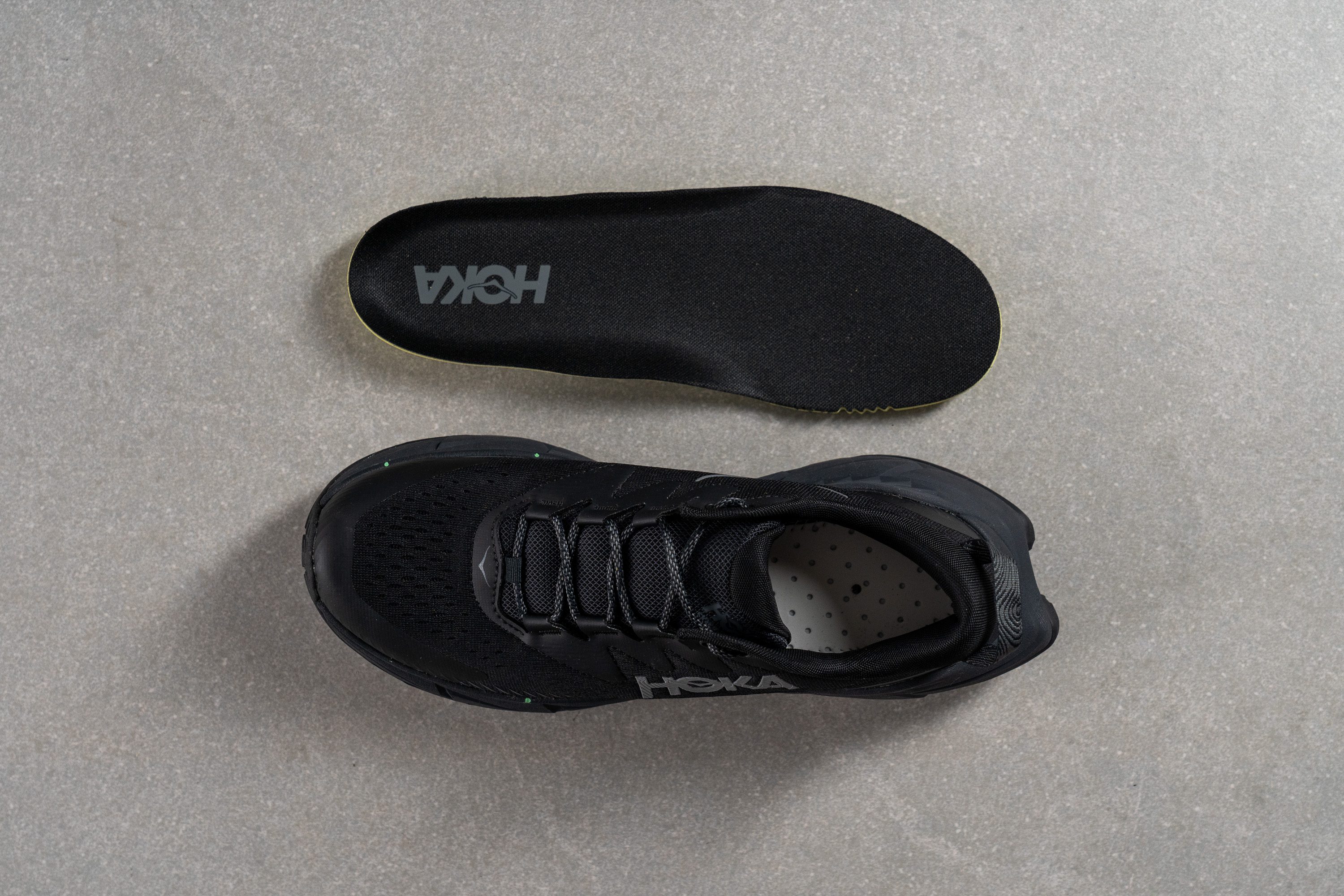
| Hoka Skyline-Float X | Yes |
Midsole softness in cold (%)
We don't come across many plant-based midsoles in the lab so we were extra curious to see how much firmer the Skyline-Float X would get when exposed to cold conditions. After chilling it in our freezer for twenty minutes, we took another durometer reading of the midsole and were quite impressed to find that it only became 11.7% more firm.

This makes the Skyline-Float X a little more consistent than the average hiking shoe and should still feel rather comfy as winter sets in.
| Hoka Skyline-Float X | 12% |
| Average | 19% |
Reflective elements
The branding and logo on the lateral and medial sides of the upper are both reflective elements that offer some level of nighttime visibility. That said, we do recommend using additional high-vis gear if walking along a sparsely-lit road after dark.
| Hoka Skyline-Float X | Yes |
Tongue padding
Using our caliper, we measured the Skyline-Float X's tongue to be 7.2 mm thick. While this may be slightly less padded than average, it still provides enough of a buffer between the laces and our instep to feel comfy and shield us from lace bite.
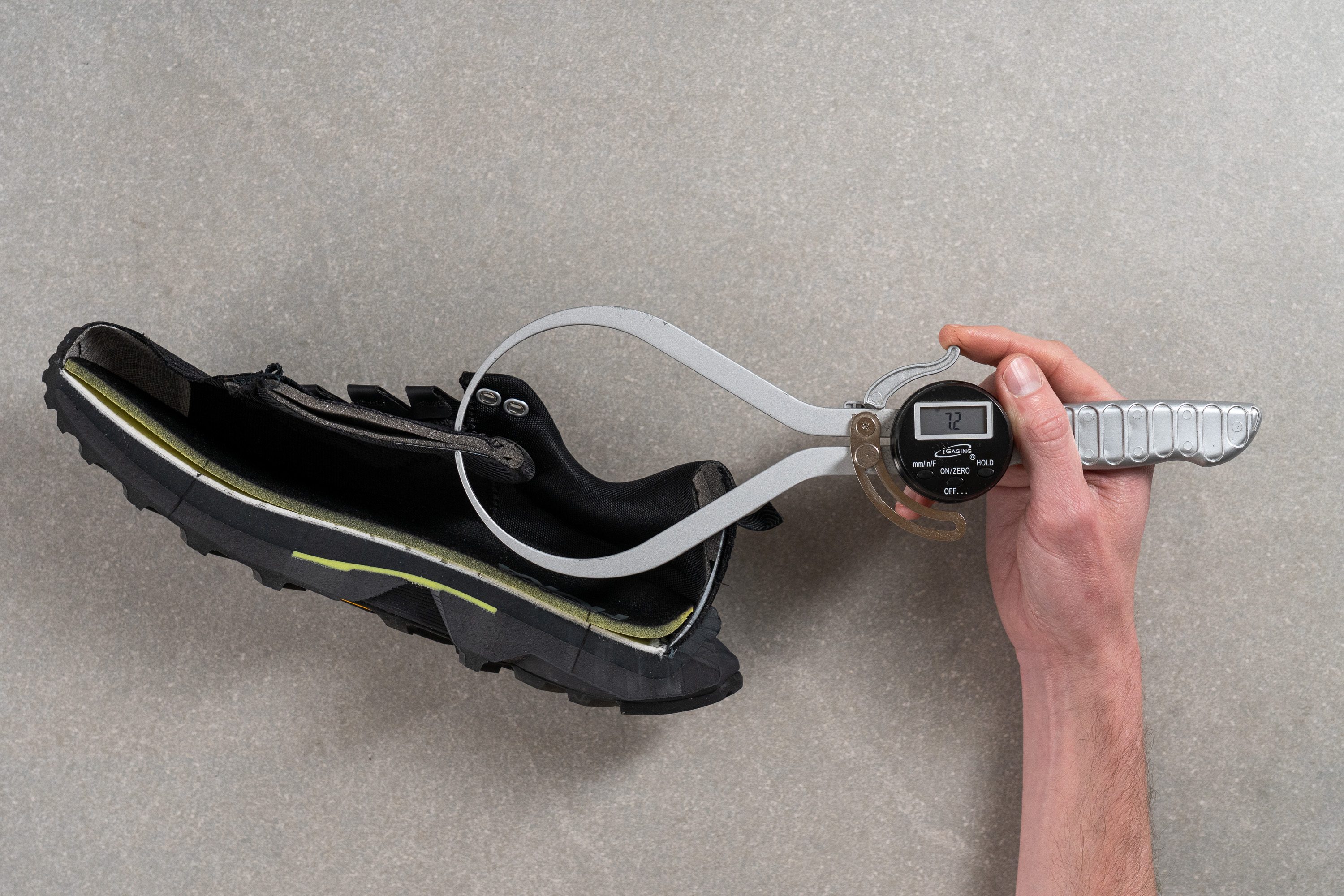
| Hoka Skyline-Float X | 7.2 mm |
| Average | 10.2 mm |
Tongue: gusset type
The tongue is fully gusseted on both sides, a feature common among hiking shoes and boots as it not only aids in a more secure lockdown but also prevents any bits of debris or grit from entering the shoe.

| Hoka Skyline-Float X | Both sides (full) |
Heel tab
There's a handy little strap attached to the heel of the Skyline-Float X that makes sliding the shoe on just a little faster and smoother.
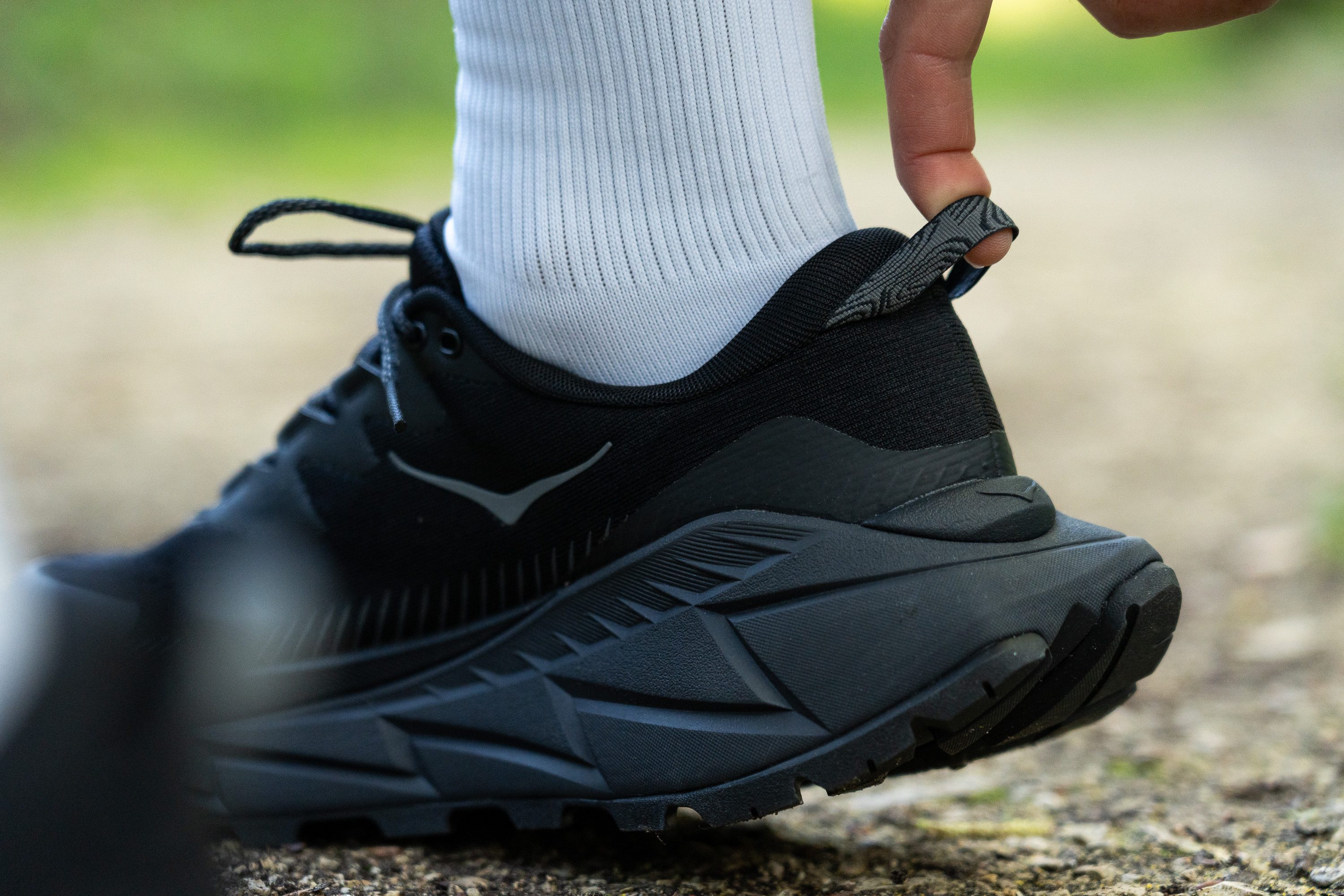
| Hoka Skyline-Float X | Finger loop |

